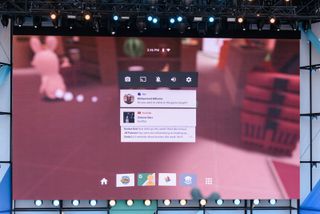Google Aims For Social VR With Daydream 2.0

Google is continuing to refine and expand Daydream, its VR-specific platform and interface. At I/O, its yearly developer’s conference, Google announced Daydream 2.0, codenamed “Euphrates,” which brings an assortment of new and refined features.
Daydream 2.0 is being built in conjunction with Android O, and will likely release in tandem with the new OS (although a release date was not specified).
The new update brings an assortment of features designed to make VR a more communal experience. Daydream 2.0 will support Google Cast, allowing players in VR games to beam their field of view to a compatible TV, Chromecast, or other streaming device. The other major addition is a built-in capture feature that will let players record their VR sessions and upload or share the videos of their virtual exploits.

No Hands
Daydream 2.0 also seems to have been built with Google’s and Qualcomm’s new standalone VR headsets in mind. These devices will run Android N, and are thus essentially android devices built entirely into a headset. Users will have to be able to launch content, navigate system settings, and use apps entirely in a VR space (and without a touch screen).
This could easily range from frustrating to impossible with a traditional Android interface (handy little Daydream controller notwithstanding), but the new Daydream has a redesigned system interface that’s a more VR-friendly layout. For example, it adds a new notification window, clearly derived from Android’s standard notification top bar, that can be called up and overlaid onto whatever VR content the user in enjoying.

Despite these new features and the fact that Google insists that Daydream is a key platform for its future (alongside Android and Chrome), relatively few devices currently support Daydream. Of the vast and varied array of Android phones on the market, only the Pixel, Moto Z, ZTE Axon 7, and Huawei Mate 9 currently support Daydream. The platform is poised to gain some traction, though, as Samsung recently announced that Daydream would be coming to its S8 line of phones in a future OS update this summer.
Considering Samsung has already sold five million S8 handsets this year, that’s sure to be a bump for Daydream’s place in the VR landscape.
Stay on the Cutting Edge
Join the experts who read Tom's Hardware for the inside track on enthusiast PC tech news — and have for over 25 years. We'll send breaking news and in-depth reviews of CPUs, GPUs, AI, maker hardware and more straight to your inbox.
-
bit_user ReplyDaydream 2.0 will support Google Cast, allowing players in VR games to beam their field of view to a compatible TV, Chromecast, or other streaming device. The other major addition is a built-in capture feature that will let players record their VR sessions and upload or share the videos of their virtual exploits.
For this not to induce motion sickness, they need some serious image stabilization. I hate watching feeds from people's VR PoV.
What they really should have is a way to get a spectator view of the experience. So, you're watching from a (relatively) fixed 3rd person perspective. Or, optionally, an image-stabilized 1st person view.
Of course, rendering from another point of view will either tax the VR device, or require the viewing device to do the rendering. So, it's not an easy goal, but I think a worthy long-term one.
Most Popular






